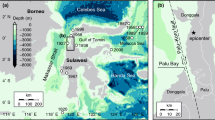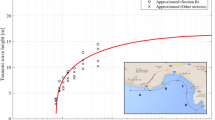Abstract
On March 11, 2011, a large earthquake that occurred offshore the north-east coast of Japan generated a large tsunami which devastated extensive areas of the Tohoku coastline. Despite Japan being considered a country well prepared for these types of disasters, large casualties were recorded, with numerous discussions amongst the Japanese coastal engineering community ensuing. As a result, two different levels of tsunamis have been proposed and now recognized in Japan, depending on the frequency of such extreme events. The idea that hard measures can protect the lives of inhabitants of coastal areas has been abandoned, and these measures are only considered to be effective in protecting properties against the more frequent but lower magnitude events. Soft measures should always be used to protect against the loss of lives, and to this respect, the authors of the paper propose the introduction of a Classification of Evacuation Areas, to show which of these should be prioritized by residents as they seek to evacuate.








Similar content being viewed by others
Notes
The “Building Standards Law Enforcement Ordinance”, originally issued in 1950, has been frequently revised. The latest modifications were made on the March 30, 2011. This ordinance does not have any section that indicated that tsunami loads shall be considered when designing normal buildings.
References
Aranguiz R (2012) The effect of a submarine canyon on tsunami propagation in the Gulf of Arauco, Chile. Int Conf of Coastal Eng ICCE2012, ASCE, Santander, Spain
ASCE (2006) Minimum design loads for buildings and other structures. ASCE/SEI Standard 7–05, American Society of Civil Engineers, Reston, Virginia, USA
ASCE (2006) Flood resistant design and construction, ASCE/SEI Standard 24–05, American Society of Civil Engineers, Reston, Virginia, USA, pp. 62
City and County of Honolulu Building Code (CCH) (2000) Department of Planning and Permitting of Honolulu Hawaii. Chapter 16 Article 11. Honolulu, Hawaii
Esteban M, Nguyen DT, Takagi H and Shibayama T (2008) Analysis of rubble mound foundation failure of a caisson breakwater subjected to tsunami attack, 18th Int Offshore and Polar Engineering Conference, Vancouver
Esteban M, Morikubo I, Shibayama T, Aranguiz Muñoz R, Mikami T, Danh Thao N, Ohira K, Ohtani A (2012) Stability of rubble mound breakwaters against solitary waves. Proc of the 33rd Int Conference on Coastal Engineering (ICCE)
Esteban M, Jayaratne R, Mikami T, Morikubo I, Shibayama T, Danh Thao N, Ohira K, Ohtani A, Mizuno Y, Kinoshita M, Matsuba S (2013) Stability of breakwater armour units against tsunami attack. J Waterways, Port, Coastal and Ocean Engineering (submitted)
Federal Emergency Management Agency (2000) Coastal Construction Manual (FEMA 55)
Federal Emergency Management Agency (2008) Guidelines for Design of Structures for Vertical Evacuation from Tsunamis. FEMA P646, Washington
Hanzawa M, Matsumoto A, Tanaka H (2012) Stability of wave-dissipating concrete blocks of detached breakwaters against tsunami. Proc of the 33rd Int Conference on Coastal Engineering (ICCE)
Headquarters for Earthquake Research Promotion (2012) www.jishin.go.jp/main/choukihyoka/kaikou.htm Accessed 07 Jan 2013 (in Japanese)
International Code Council, INC (2006) International building code IBC 2006. Country Club Hills, IL
Kakinuma T, Tsujimoto G, Yasuda T, Tamada T (2012) Trace survey results of the 2011 Tohoku Earthquake Tsunami in the North of Miyagi Prefecture and Numerical Simulation of Bidirectional Tsunamis in Utatsusaki Peninsula, Coastal Engineering Journal, JSCE 54(1)
Kato F, Suwa Y, Watanabe K, Hatogai S (2012). Mechanism of coastal dike failure induced by the Great East Japan Earthquake Tsunami. Proc of the 33rd Int Conference on Coastal Engineering (ICCE)
Mikami T, Shibayama T, Esteban M, Matsumaru R (2012) Field Survey of the 2011 Tohoku Earthquake and Tsunami in Miyagi and Fukushima Prefectures. Coastal Engineering Journal (CEJ) 54(1):1–26
Minoura K, Imamura F, Sugawara D, Kono Y, Iwashita T (2001) The 869 Jogan Tsunami deposit and recurrence interval of large-scale tsunami on the Pacific coast of northeast Japan. J of Natural Disaster Science 23:83–88
Mori N, Takahashi T, The 2011 Tohoku Earthquake Tsunami Joint Survey Group (2012) Nationwide Post Event Survey and Analysis of the 2011 Tohoku Earthquake Tsunami, Coastal Engineering Journal JSCE 54(1)
Nistor I, Palermo D, Nouri Y, Murty T, Saatcioglu M (2009) Tsunami forces on structures. Handbook of coastal and ocean engineering. World Scientific, Singapore, pp 261–286
Nistor I, Palermo D, Cornett A, Al-Faesly T (2010) Experimental and numerical modeling of tsunami loading on structures. Int Conf of Coastal Eng ICCE2010, ASCE, Shanghai, China, 10 p
Nouri Y, Nistor I, Palermo D, Cornett A (2010) Experimental investigation of tsunami impact on free standing structures. Coastal Engineering Journal 52(1):43–70
Ogasawara T, Matsubayashi Y, Sakai S and Yasuda T (2012) Characteristics on Tsunami Disaster of Northern Iwate Coast of the 2011 Tohoku Earthquake Tsunami, Coastal Engineering Journal, JSCE 54(1)
Okada T, Sugano T, Ishikawa T, Ohgi T, Takai S, Hamabe C (2005) Structural design method of buildings for tsunami resistance (SMBTR), a code proposed by The Building Technology Research Institute of The Building Center of Japan 2005
Port and Airport Research Institute (PARI) (2011) Verification of breakwater effects in Kamaishi Ports.http://www.pari.go.jp/info/tohoku-eq/20110401.html Accessed 19th July 2011 (in Japanese)
Sakakiyama T (2012) Stability of armour units of rubble mound breakwater against tsunamis. Proc of the 33rd Int Conference on Coastal Engineering (ICCE) (in press)
Sawai Y, Okamura Y, Shishikura M, Matsuura T, Than TA, Komatsubara J and Fujii Y(2006) Historical tsunamis recorded in deposits beneath Sendai Plain -inundation areas of the A.D. 1611 Keicho and the A.D. 869 Jogan Tsunamis-. Chishitsu News no.624, p. 36–41 (in Japanese)
Shimozono T, Sato S, Okayasu A, Tajima Y, Fritz HM, Liu H and Takagawa T (2012) Propagation and Inundation Characteristics of the 2011 Tohoku Tsunami on the Central Sanriku Coast, Coastal Engineering Journal, JSCE, 54(1)
Suppasri A, Koshimura S, Imai K, Mas E, Gokon H, Muhari A, Imamura F (2012) Field Survey and Damage Characteristic of the 2011 East Japan Tsunami in Miyagi Prefecture, Coastal Engineering Journal, JSCE 54(1)
Takahashi S et al (2011) Urgent Survey for 2011 Great East Japan Earthquake and Tsunami Disaster in Ports and Coasts, Technical Note of the Port and Airport Research Institute, No.1231, p.157 (in Japanese)
The 2011 Tohoku Earthquake Tsunami Joint Survey Group (299 authors 2011) Nationwide Field Survey of the 2011 Off the Pacific Coast of Tohoku Earthquake Tsunami. J Japan Society of Civil Engineers 67(1):63–66
Van der Meer JW (1987) Stability of breakwater armour layers. Coast Eng 11:219–239
Watanabe H (1985) Comprehensive bibliography on tsunami of Japan, University of Tokyo Press, Tokyo, 260p (in Japanese)
Watanabe Y, Mitobe Y, Saruwatari A, Yamada T and Niida Y (2012) Evolution of the 2011 Tohoku Earthquake Tsunami on the Pacific Coast of Hokkaido, Coastal Engineering Journal, JSCE, 54(1)
Acknowledgments
The authors would like to acknowledge the kind financial contribution of the “Disaster Analysis and Proposal for Rehabilitation Process for the Tohoku Earthquake and Tsunami” Institute for Research on Reconstruction from the Great East Japan Earthquake/Composed Crisis Research Institute from Waseda University Research Initiatives. Two anonymous reviewers also provided comments that helped improve the quality of the paper, and their help is kindly appreciated.
Author information
Authors and Affiliations
Corresponding author
Rights and permissions
About this article
Cite this article
Shibayama, T., Esteban, M., Nistor, I. et al. Classification of Tsunami and Evacuation Areas. Nat Hazards 67, 365–386 (2013). https://doi.org/10.1007/s11069-013-0567-4
Received:
Accepted:
Published:
Issue Date:
DOI: https://doi.org/10.1007/s11069-013-0567-4




